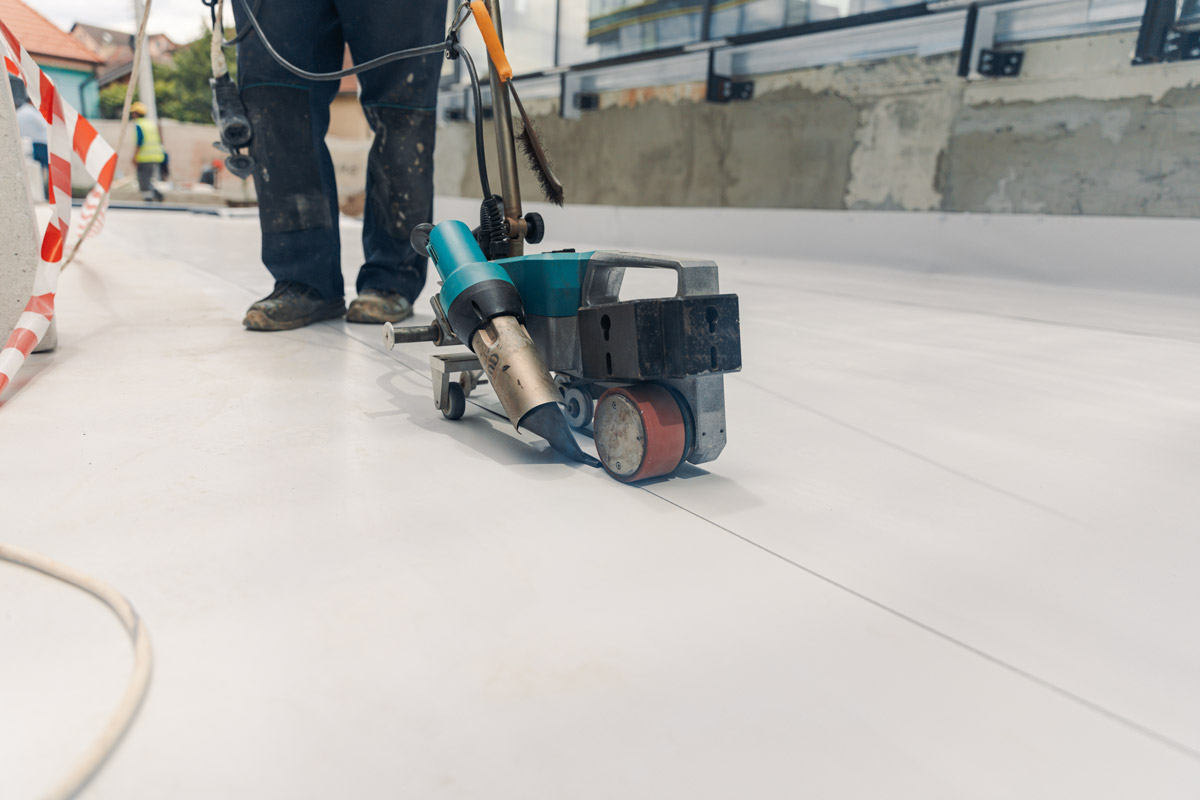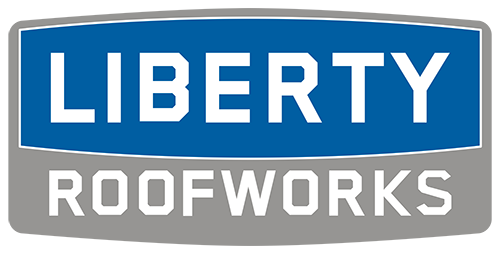PVC Roofs
PVC, which is made of polyvinyl chloride, gives owners of commercial properties a robust, long-lasting roofing option. This well-liked ply layer aids in shielding your home from all sorts of terrible weather conditions. It is lightweight, low maintenance, and weather and fire-resistant.
Thanks to its reflective characteristics, which help cover up most of the sun’s harmful UV rays, one of its most well-liked qualities may be its capacity to make your house more energy efficient.
Given all of this, it is not a surprise that PVC is frequently a top choice for commercial buildings around the nation. Can homeowners, however, also benefit from using this fantastic material? We will go through PCV’s ins and outs in the following article, so keep reading to find out.

Contact Liberty Roofworks Today
Let Liberty Roofworks’ qualified roofers in Rock Hill, South Carolina handle your roofing needs. For your convenience, we offer a free roof inspection and quote.
Overview of PCV
Polyvinyl chloride is referred to as PVC. PVC, a synthetic plastic polymer, is used to create a flexible and long-lasting roofing material. Once installed, PVC requires relatively little maintenance, and when it does, the repairs are often fairly minor. PVC is available in various hues, including white, which helps reduce cooling expenses, particularly in the South. Every 20 years, flat roofs generally need to be replaced, and PVC is no exception. However, compared to other roofing materials, ownership and installation costs are often far lower.
Benefits of PVC Roofs
Low-slope and flat roofs can also be covered with PVC roofing. If your house features a pitched-roof design, you could still use PVC roofing on several other places on your property.
PVC is resistant to fire, as was already indicated. However, it is also resistant to chemicals, making it the perfect option for fast-food businesses and restaurants that deal with all sorts of oils and flammable materials.
There are many additional ways PVC roofing might improve your home property, even if you might not require this particular benefit. Some of these benefits are the following.
Longevity
How durable are PVC roofs? PVC roofs may often endure for more than 20 years. Naturally, this relies on several variables, including the following:
- Its maintenance habits
- Repairs
- Climate circumstances
The longevity of PVC is equivalent to that of other popular residential roofing materials, which tend to last for 15 to 40 years.
Wind & Leak Protection
PVC roofing membranes are solid and an excellent option for those living in places with fast and terrible winds. It has even been shown to endure wind speeds up to 130 mph and boasts a robust wind uplift rating.
Additionally, because the membrane’s seams are welded rather than joined with adhesive tape, your home will be less likely to be damaged by rain, hail, or snow.
Low Maintenance
If less cleaning and upkeep appeal to you, you’ll be happy to find out that this type of roofing needs fewer repairs than conventional residential roofs. Furthermore, PVC roofs are significantly simpler (and quicker) to maintain when they need to be repaired since a skilled roofer can mend them and put the PCV membranes back into place.
This is another advantage of PVC for business buildings that you can also enjoy.
Environmentally Friendly
PVC roofs are a terrific option to save energy and minimize electricity costs as more homes explore ways to lessen their carbon footprint.
This material is regarded as environmentally beneficial since it requires less energy. It reflects the sun’s intense heat and UV rays, so PVC has an Energy Star certification and is regarded as one of the first cooling roofing systems, keeping the inside of the house cool and cozy.
Reflectivity
Although thermoplastics are available in various hues, light hues are more common. Light-colored roofs are more reflective and excel at reflecting heat from the sun. Because pure white roofs can make dirt appear more evident, PVC membranes are often offered in light gray, tan, and off-white hues.
Several Attachment Options
Mechanical fasteners and completely adherent systems are the best options for attaching PVC systems. The quantity of seams that need to be sealed in the field is reduced since manufacturers may create these sheets into large panels in the plant. Depending on the anticipated wind loads, the fastening pattern can be altered.
Components of a PVC Roof
Each PVC roofing installation requires several layers of materials, each of which has a certain function:
- Roof Deck: The layer of sturdy material fastened to structural supports is known as the roof deck. It serves as a base for further PVC roofing components.
- Insulating Layer: Each PVC roof has an insulating layer, which normally sits on the roof deck. Energy efficiency and local weather trends determine the kind and thickness.
- Fasteners and Plates: The membrane sheets and roof deck are connected securely using fasteners and plates.
- Adhesives: Depending on the weather and other variables, these can be the best choice for installing a PVC roof. Adhesives are occasionally a good option in areas where windstorms are common.
Important to note is that if a ventilation pipe, HVAC system, or parapet goes through the roof, flashing and sealants are used.
A parapet must be adequately sealed and flashed during the installation of a high-quality PVC roof to guard against moisture intrusion and water damage.

Types of PVC Roofing
Since the 1960s, installations of flat and low-slope roofs have frequently used this category of materials.
PVC roofing systems have become more popular due to their easy installation, lighter weight on structural components, and resistance to bad weather.
Standard PVC Roof Membrane
PVC roofing membrane is often sold as a single-ply product.
Industry-leading PVC membrane roof materials have earned the Energy Star rating and are created to provide long-term heat reflection and water damage prevention.
A typical PVC roofing system typically consists of two membrane layers, with polyester acting as reinforcement in the center.
Standard PVC may often be placed using bolts or adhesives, and additives enhance flexibility.
PVC KEE Roof Membrane
Rigid components must be changed to make them more flexible throughout the PVC roof membrane materials manufacturing process.
The liquid plasticizers that were utilized to make this possible may eventually evaporate. Ketone Ethylene Ester (KEE) was created for this reason.
A concentrated polymer additive in KEE PVC membrane roofing products outperforms several liquid plasticizers.
In essence, a PVC KEE membrane extends a roof’s lifespan by keeping its flexibility longer.
This group of PVC membrane roofing materials reflects the sun’s rays well over time and may also be used in conjunction with asphalt.
Fleece Backed PVC Roof Membrane
High-quality fleece components are fastened to a PVC membrane roofing product’s underside to supply support for low-slope or flat roofs.
Materials, including fleece, are simpler to install since they can be laid on the roof.
This method results in a PVC roofing layer that is very protective while using less work.
Utilizing fleece-backed goods gives a PVC roof installation the flexibility of being fastened with adhesives or fasteners.
Due to its resilience to extreme weather events, adhesive PVC roofing installation is frequently used by buildings in areas subject to strong winds.
Property owners and managers need to know that fleece backing is an option for regular and KEE products.
The choices made regarding the materials utilized in a PVC roof installation are primarily influenced by structural soundness, architectural design, and weather conditions. A PVC roofing specialist can explain the procedure to you and address any questions.
Installing a PCV Roof
Commercial PVC roofing systems require professional installation, like other flat roof systems. A PVC membrane, which offers rugged leak protection and fares well against the weather, is supported by a structural deck. One of the many reasons a professional should put PVC is that it is heat-welded. The seams are fused with a tiny flame, and an expert must carefully inspect them to ensure their durability.
How Does It Look?
PVC is a stylish material that has been extensively altered. It is available in a variety of hues and styles. This material’s flexibility is unrivaled. Even PVC systems meant to be simple to install can be placed directly on top of your existing system.
Estimate Price
Commercial and industrial roofing systems made of PVC are reasonably priced. It works particularly effectively in warmer regions. PVC maintenance costs are likewise relatively low. This material is recognized as a straightforward and dependable material, so any maintenance your PVC roof needs is unlikely to be substantial. You’ll still need to employ a qualified roofing contractor to complete the work.
How Does It Compare to Other Materials?
Currently, PVC is the third most used material for single-ply roofing systems. All single-ply roofing systems share versatility, simplicity of installation and maintenance, and other advantages. However, PVC truly stands out in terms of value for money and flexibility since it allows for greater customization of its appearance and texture than other roofing systems. Because of this, roofing contractors frequently use it.
Frequently Asked Questions about PVC Roofing
Here are some of the most commonly asked questions about PVC roofs:
How Long Do PVC Roofs Last?
PVC roofs can last up to 25 years with proper maintenance.
Are PVC Roofs Energy-efficient?
Yes, PVC roofs can reflect up to 85% of the sun’s rays, which can help reduce energy costs.
How Much Do PVC Roofs Cost?
The cost of PVC roofs varies depending on the size and complexity of the project. Generally, PVC roofs cost more than other types of roofs, but they are also more durable and long-lasting.
Are PVC Roofs Challenging to Install?
No, PVC roofs are relatively easy to install, and your nearby expert roofer can do it quickly.
In summary, PVC is a highly reliable material that plenty of homeowners and business owners choose for their properties because of all the benefits they get from it. If you’re interested in it, please give us a call to get a free estimate for our services. Contact Liberty Roofworks Today to get started on your PVC roofing project.
